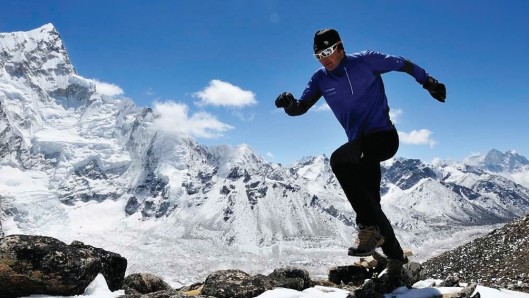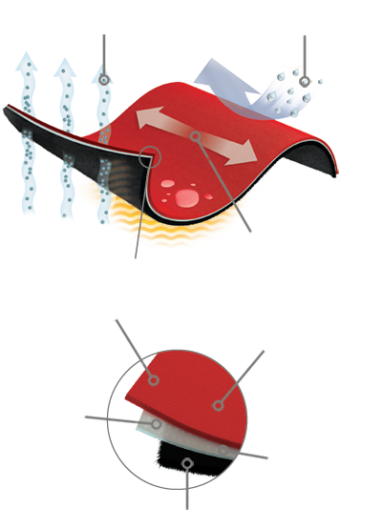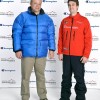Future Fabrics: High-tech materials attempt to beat mother nature at her own game
By Chris Weiss
17:29 December 6, 2011

Mountain Hardwear's Dry.Q water-proof breathable fabric is among a new breed of sporting apparel (Photo: Athlete Ueli Steck, Photo Credit: Robert Bosch / Mountain Hardware)
Outdoor sports equipment has evolved thoroughly over the years, from simple designs crafted out of everyday materials like wood and twine to advanced, highly specialized gear composed of space-age materials like carbon and Kevlar. This evolution has empowered generation upon generation of elite athletes to push their sports to more difficult terrain, more distant locations and more awe-inspiring feats. The better the gear, the better the sport.
The evolution of outdoor apparel technology has been on a much slower track. Many materials that dominate today's outdoor clothes - wool and down, for instance - have been plucked straight from nature for hundreds of years. While textile manufacturers and clothing companies have tried to improve upon natural designs, they've generally failed to come up with anything that unequivocally surpasses Mother Nature. Meanwhile, the disadvantages of staple fabrics persist, limiting athletes. While lack of fabric innovation doesn't necessarily ground athletes' ambitions altogether, it does complicate logistics and make their lives more difficult and less comfortable.
Just beyond the action videos and gear shops, though, a new dawn is breaking. An improved generation of materials with the potential to displace stale staples is slowly moving from test labs to retail shelves. If these materials can brave the real world and live up to the hype, outdoor apparel - and outdoor sports - will look very different in the future.
Zero-Loft Aerogels
For centuries, the big, puffy down jacket has stood as a symbol of exotic cold-weather adventure in the likes of Mount Everest and Antarctica. Nothing man-made has touched the warmth-to-weight ratio of down.
Down may be warm and comfy, but it's not without its negatives. Down's warming ability relies on its loft, making it thick and bulky. When down gets wet or compacted, its loft diminishes and its warming value decreases markedly.
Zero-Loft Aerogels is a material that aims to supplant down as the ultimate in cold-weather insulation. It is a thin, flexible silica gel-based material that consists of more than 90 percent air. It does not rely on loft, offering two to three times the thermal performance of down without the fluffy bulk. Zero-Loft Aerogels material is not prone to failure from pressure or moisture, so the fabric maintains its thermal properties regardless of the conditions.
Far from an experimental material, Zero-Loft Aerogels has been used in demanding insulation applications in multi-billion dollar industries like aerospace and petroleum transport.
In 2010, sportswear company Hanesbrands debuted the experimental Supersuit, an Aerogels-based outerwear jacket just 3 mm thick. The suit's initial test leg was a Mount Everest expedition. Met with temperatures as low as -40°F (-40°C), team leader Jamie Clarke said the jacket was the warmest he'd ever worn, particularly in low-aerobic situations. Research on the suit and its market implications remains ongoing.
More than a one-trick pony, Zero-Loft Aerogels has the ability to insulate from heat as well as cold. Aerogels insoles have protected runners from the staggering heat of the Sahara Desert. Because it has the lowest thermal conductivity of any solid, Aerogels is able to keep athletes' feet protected and limber even in extreme 120+°F (49°C) temperatures.
Berghaus Hydrophobic Down
You don't necessarily have to compete against down to innovate. U.K. outdoor clothing company Berghaus recently took more of collaborative approach. Since many manufacturers before it failed to effectively deliver a synthetic with down's same combination of warmth, light weight and compactable build, Berghaus decided to simply address down's major con: failure in wet conditions.
Hydrophobic down is quite possibly the simplest, smartest solution to down's nagging downfall. The down is coated in durable water repellent (DWR) prior to being stuffed into Berghaus' clothing. Unlike regular down, which gets matted and loses insulation value the minute the rain starts, the DWR-coated down retains up to 80 percent of its loft after three minutes in water. Simply put, you can wear your water-resistant down jacket in cold, nasty Pacific Northwest rain storms and still enjoy that warm, fuzzy feeling. Berghaus uses a mixture of hydrophobic down and Primaloft insulation in its new Mount Asgard Hybrid jacket.
Air Permeable Outerwear
For decades, Gore-Tex has been the established leader in waterproof fabric for winter outerwear. Over the past few years, though, discontent with Gore-Tex fabrics has been growing among outdoor enthusiasts. While its ability to protect against water and wind remains unquestioned, Gore-Tex has been criticized for its lack of breathability. With an increasing number of athletes participating in more aerobic forms of winter recreation like ski touring and mountaineering, breathability has become as big a need as waterproofing.
Consumers have had to compromise by choosing either a fully waterproof hard shell or a breathable, less waterproof soft shell. This year, several different fabrics from manufacturers like Polartec and Mountain Hardwear have addressed this forced compromise with a better solution: air permeable fabric.
Unlike Gore-Tex, which relies on the slower process of heat diffusion to vent perspiration, new fabrics like Polartec Neoshell and Mountain Hardwear Dry.Q allow a nominal amount of airflow, helping to more quickly and effectively carry moisture away from your body. Meanwhile, they remain totally water and windproof. You get breathability comparable to a soft shell and waterproofing on par with a hard shell. You stay 100 percent dry from the inside and out.
Polartec Neoshell
Given the sheer number of manufacturers - Marmot, The North Face, Westcomb, Columbia and others - launching air-permeable jackets this winter, it would be surprising if fabrics like Neoshell and Dry.Q don't gain some sort of foothold in the industry. At the very least, we'd expect them to inspire some air-permeability innovation at W.L. Gore and Associates.
Though innovations in fabric aren't necessarily as exciting as hardware innovations, they have the potential to have just as much impact on the future of outdoor sports. If these fabrics prove themselves, outdoor athletes of all kinds will be able to travel farther, longer and more comfortably.
Copyright © gizmag 2003 - 2011 To subscribe or visit go to: http://www.gizmag.com

